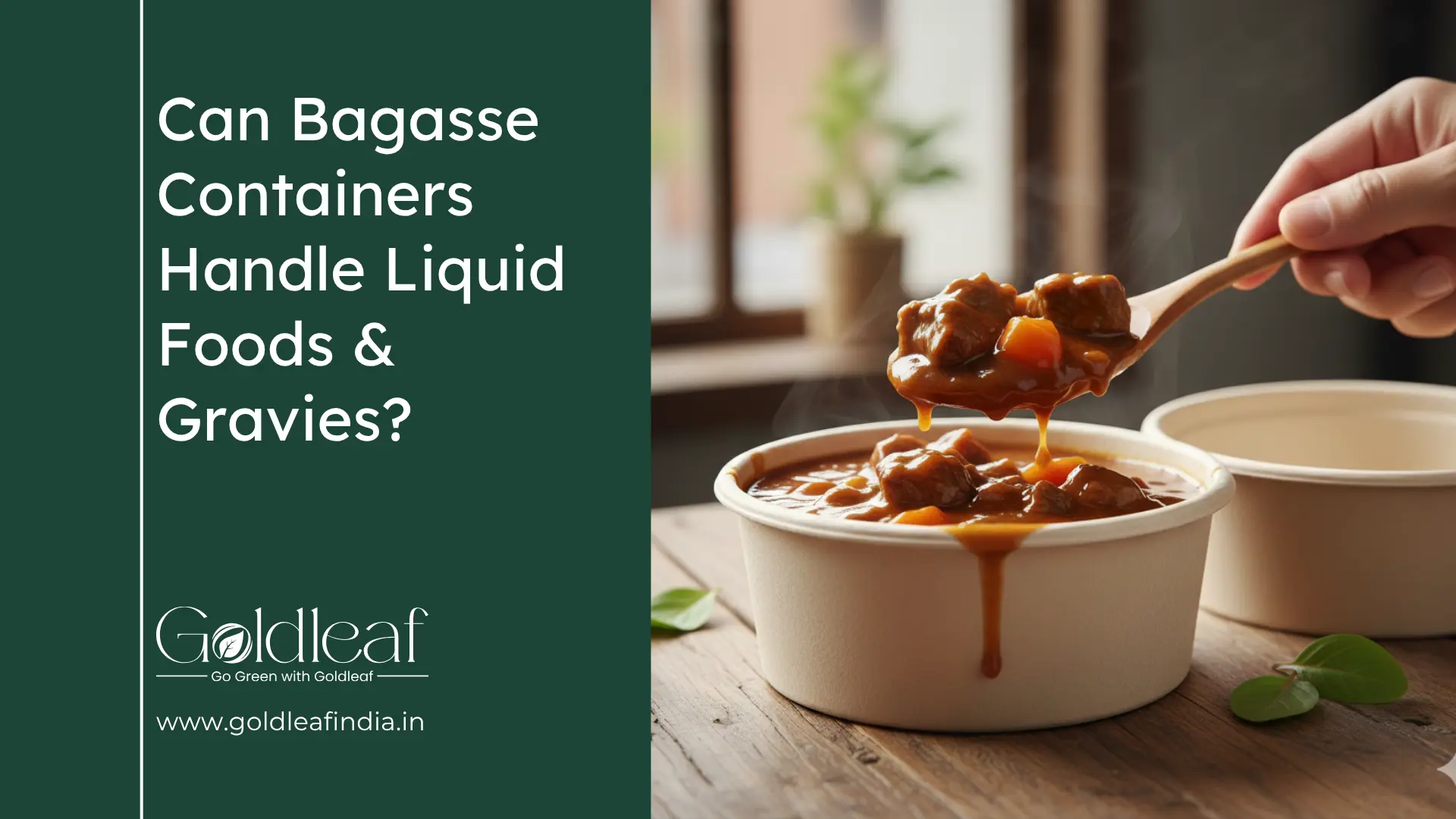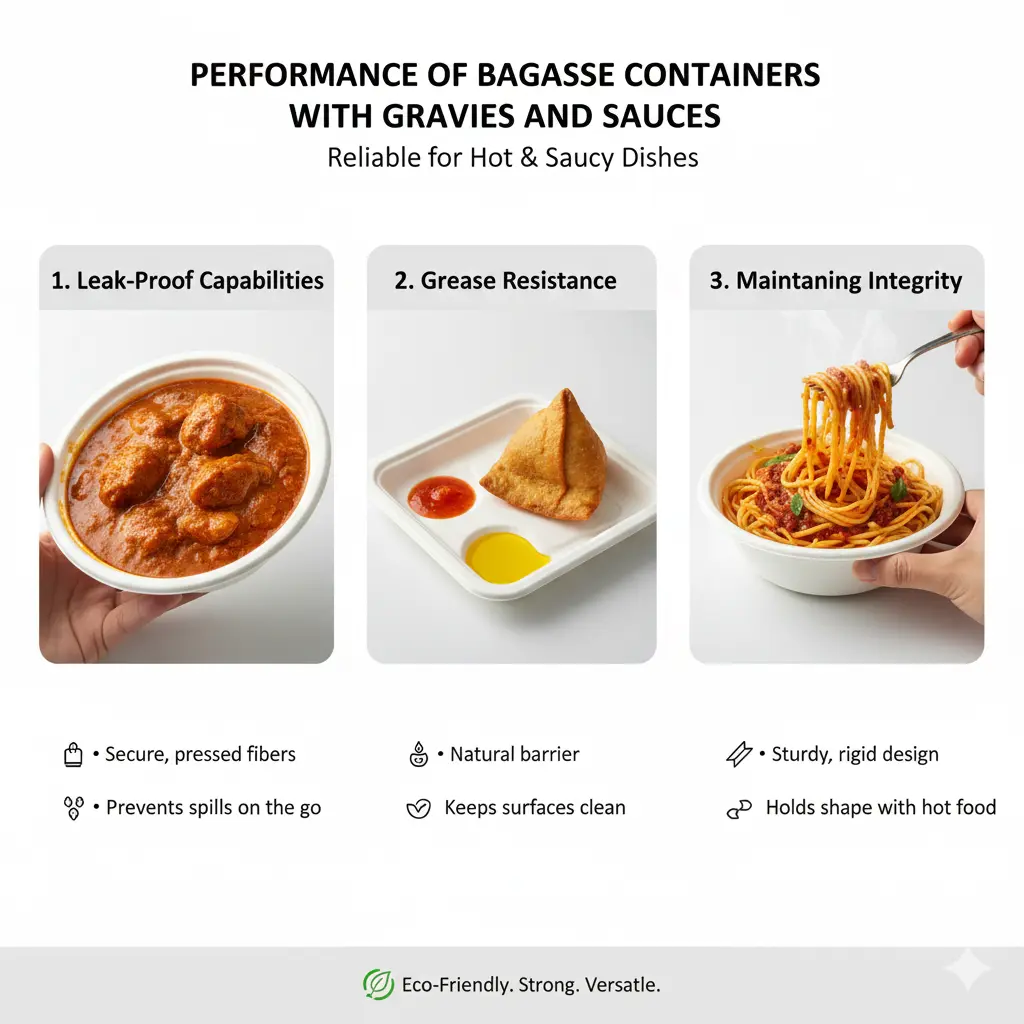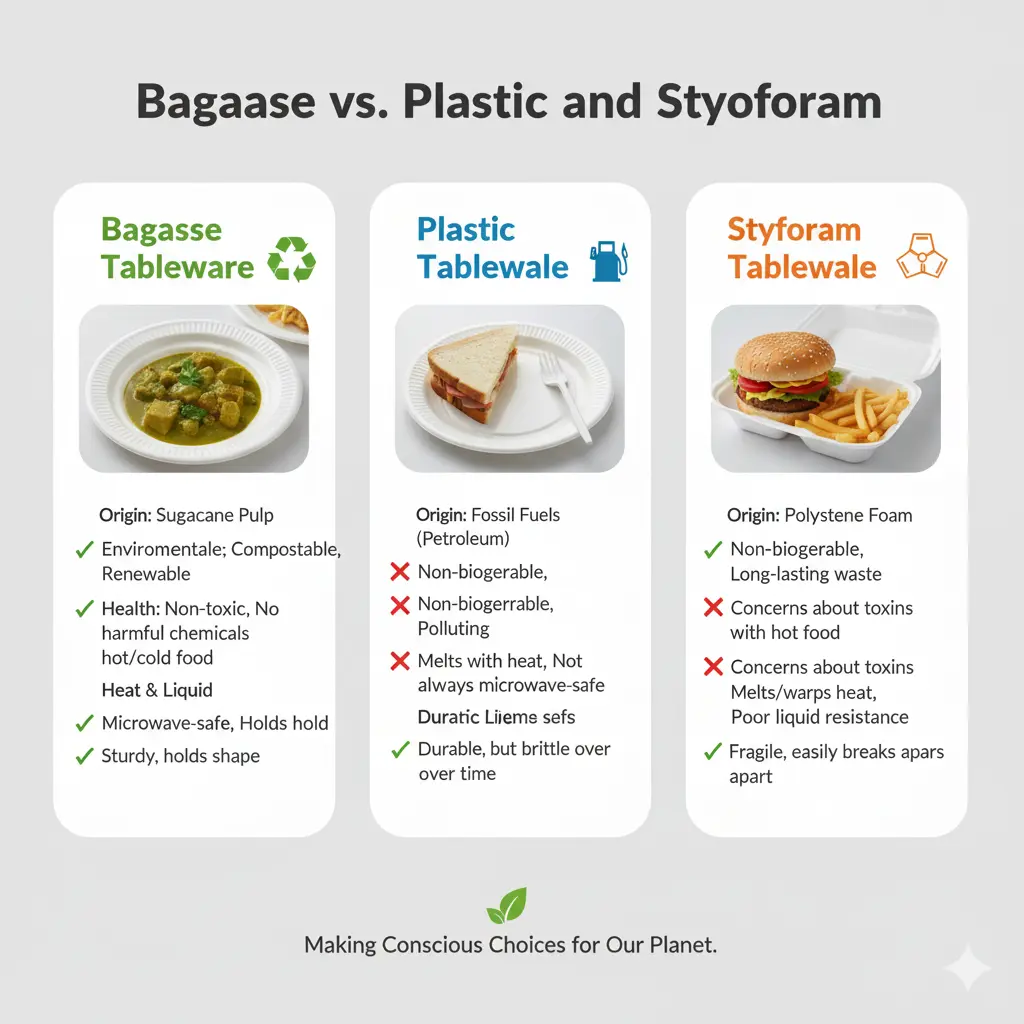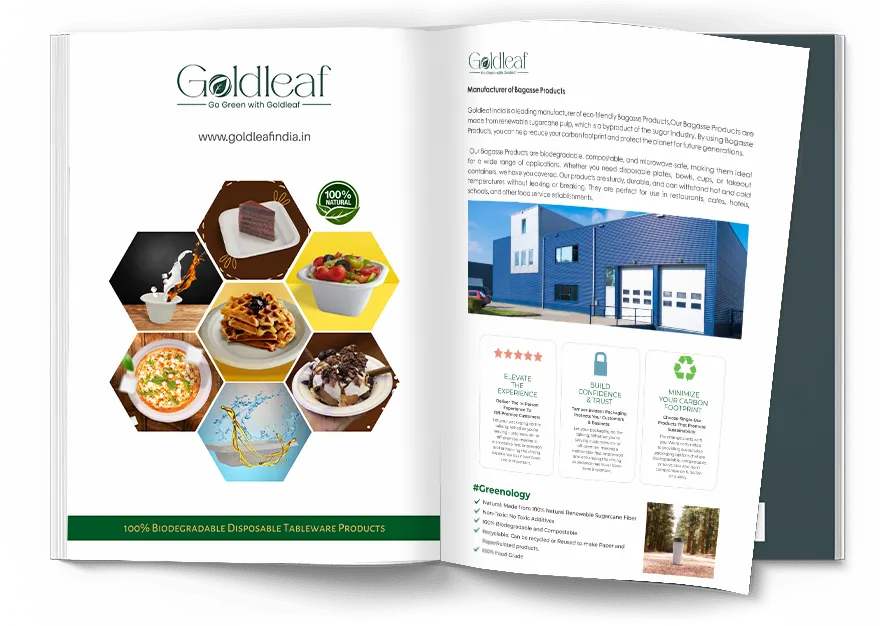Свържете се с нашия екип

- 31
Thinking about switching to eco-friendly food containers? Bagasse containers, made from sugarcane fibers, are popping up everywhere. But can these plant-based options really handle saucy dishes and greasy fries without making a mess? We're going to look into how bagasse containers perform with liquid foods and gravies, compare them to other packaging, and see where they fit best in the food service world.
Key Takeaways
• Bagasse containers are generally good with water and oil, thanks to how they're made and sometimes treated with food-safe coatings.
• These containers are pretty sturdy and can hold up well, even with hot or heavy foods, making them a solid choice for delivery.
• They can handle both microwave and freezer temperatures, which is super convenient for storing and reheating food.
• Compared to plastic and styrofoam, bagasse is way better for the environment because it breaks down naturally, and it often looks nicer to customers.
• When serving really wet or greasy foods, picking thicker bagasse containers and not overfilling them helps prevent any leaks or messes.
Understanding Bagasse Containers For Liquid Foods
Bagasse containers, made from the leftover fibers of sugarcane, are becoming a popular choice for food businesses. They offer a greener alternative to traditional packaging, but how well do they actually hold up with liquid foods and gravies? Let's break down what makes them work.
Water and Oil Resistance in Bagasse Packaging
These containers are designed to handle liquids and oils surprisingly well. This is achieved through a couple of key features. First, the natural fibers of bagasse are pressed together tightly during manufacturing, creating a dense material that's less likely to absorb moisture. Second, many bagasse food containers are treated with a food-safe, compostable coating. This coating acts as a barrier, preventing liquids and oils from seeping through. It’s a clever way to keep your food contained without using plastics that stick around forever. This makes them a solid option for saucy dishes or fried foods, reducing the mess during transport or serving.
Sturdiness and Durability of Sugarcane Containers
Don't let the plant-based origin fool you; bagasse containers are built tough. They are molded under high pressure, which gives them a rigid structure. This means they won't easily bend or collapse, even when filled with heavier foods like curries or pasta dishes. You can stack them without worrying about them crushing each other, which is a big plus for busy kitchens and delivery services. Their durability means they hold their shape from the kitchen to the customer's table.
Temperature Tolerance: Microwave and Freezer Safety
One of the big advantages of bagasse is its versatility when it comes to temperature. These containers are generally safe to use in both the microwave and the freezer. This means you can prepare food ahead of time, store it, and then reheat it all in the same container. This convenience is a major selling point for many food businesses and their customers. Just be sure to check the specific product guidelines, as some coatings might have temperature limits, but generally, they hold up well to both hot and cold.
• Microwave safe for reheating
• Freezer safe for food storage
• Maintains integrity with hot foods
Performance of Bagasse Containers with Gravies and Sauces

When you're serving up something saucy or a little on the greasy side, you want to know your container can handle it. Bagasse, made from sugarcane fibers, really steps up to the plate here. It's not just about being eco-friendly; these containers are built to perform, even with messy foods.
Leak-Proof Capabilities for Saucy Dishes
One of the biggest worries with saucy foods is, well, leaks. Nobody wants a gravy-stained bag or a messy car seat. Bagasse food packgaging are surprisingly good at keeping liquids contained. The natural fibers, when pressed and heated, create a dense material that doesn't easily let liquids seep through. For dishes like curries, stews, or pasta with a rich sauce, bagasse containers generally hold up well, preventing those dreaded drips and spills. It's a big step up from some other disposable options that can get soggy or start to break down.
Grease Resistance of Natural Sugarcane Fibers
Grease is another common challenge. Fried foods, oily stir-fries, or even a rich dressing can test the limits of a container. Bagasse's natural composition offers a decent level of grease resistance. The fibers themselves don't absorb oil as readily as, say, plain cardboard might. This means your container stays stronger for longer, and you don't end up with greasy spots showing through the bottom or sides. It helps keep the food contained and the outside of the container clean.
Maintaining Integrity with Hot and Oily Foods
Combining heat, oil, and sauce can be a tough test for any food packaging. Sugarcane Food containers generally handle this combination quite well. They are designed to withstand higher temperatures without deforming or becoming weak. This means you can serve piping hot, oily dishes without worrying about the container collapsing or melting.
Here's a quick look at how they stack up:
• Heat Tolerance: Can handle hot foods without warping.
• Oil Handling: Resists grease penetration.
• Structural Integrity: Maintains shape even with saucy or oily contents.
Comparing Bagasse Containers to Other Food Packaging
When you're trying to figure out the best way to package food, especially things with sauce or oil, it's good to look at what else is out there. Bagasse containers have really started showing up everywhere, and for good reason. But how do they really stack up against the old standards like plastic, styrofoam, and even cardboard?
Bagasse vs. Plastic and Styrofoam

Let's be honest, plastic and styrofoam have been the go-to for a long time. They're cheap and they work, sort of. But the big difference is what happens after you're done with them. Bagasse is made from sugarcane fibers, which means it breaks down pretty quickly, usually within a couple of months if you compost it. Plastic, on the other hand, can stick around for hundreds of years, just piling up in landfills or, worse, in the ocean. Styrofoam is pretty much the same story it doesn't go away easily.
Plus, when it comes to food safety, bagasse is generally considered better. It doesn't have those iffy chemicals like BPA that you sometimes find in plastics. And for holding saucy or oily foods, bagasse containers are surprisingly good. They're naturally resistant to grease and moisture, which means fewer leaks and less mess during delivery. Plastic can sometimes warp with heat, and styrofoam isn't exactly known for its sturdiness when things get hot or greasy.
Here’s a quick look:
| Feature | Bagasse | Plastic | Styrofoam |
|---|---|---|---|
| Eco-Friendly | Compostable | Non-biodegradable | Non-biodegradable |
| Microwave/Freezer Safe | Yes | No | No |
| Grease & Liquid Resistance | High | Medium | Low |
| Durability | Strong | Strong | Fragile |
| Customer Appeal | Premium & eco | Negative | Negative |
Bagasse vs. Cardboard for Wet Foods
Cardboard containers are another common option, especially for dry goods. They can be okay for some things, but when you add liquids or grease, they can get soggy and lose their shape pretty fast. Bagasse, with its natural fibers and sometimes a special coating, holds up much better. It’s designed to keep liquids and oils contained, making it a more reliable choice for dishes like curries, pasta with sauce, or anything with a dressing. While cardboard might be recyclable, its performance with wet foods is often lacking, leading to potential leaks and a less-than-ideal customer experience. For anything beyond a simple sandwich, bagasse usually wins out.
Customer Appeal of Eco-Friendly Bagasse
There's no doubt about it, people like seeing that a business is making an effort to be more sustainable. When customers get their food in bagasse clameshell, it often feels like a more premium experience. It looks natural and clean, and knowing it's better for the planet is a big plus. This can really help a business stand out, especially in the busy world of food delivery. It’s not just about the food anymore; the packaging plays a role in the overall impression.
Applications of Bagasse Containers in Food Service
As more people care about the planet, businesses are looking for ways to be greener. This is where bagasse containers really shine. Made from sugarcane fibers, these containers are a fantastic alternative to plastic for many food service needs. They're not just good for the environment; they actually work really well for a lot of different foods.
Ideal Use in Food Delivery Services
Food delivery has gotten huge, and with that comes the need for containers that can handle the journey. Bagasse takeaway containers are perfect for this. They're sturdy enough to stack without crushing and, importantly, they can hold saucy or oily foods without leaking. This means your customers get their meals looking just as good as when they left the kitchen. Using sugarcane bagasse products for delivery helps reduce plastic waste and shows customers you care about sustainability, which can really boost your brand's image.
Suitability for Catering and Events
When you're catering an event, whether it's a wedding or a corporate lunch, you need packaging that looks good and performs well. Bagasse food containers, including clamshells and bowls, offer a natural, appealing look that fits many event styles. They're strong enough for heavier foods and can handle hot dishes straight from the oven. Plus, knowing that the packaging is compostable makes cleanup much easier and more environmentally friendly for everyone involved.
Convenience for Retail and Takeaway Counters
For quick-service restaurants, cafes, and food trucks, convenience is key. Bagasse food containers are easy to handle, stack, and serve from. They work great for everything from salads and sandwiches to pasta dishes with sauce. The natural texture of sugarcane food containers often appeals to customers looking for healthier or more natural food options. They're a simple switch that makes a big difference in reducing waste at the counter.
Here's a quick look at why bagasse is a great choice:
• Leak-Proof: Great for gravies, curries, and anything with a sauce.
• Heat-Resistant: Can handle hot foods without getting flimsy.
• Durable: Strong enough for full meals and transport.
• Eco-Friendly: Biodegradable and compostable, unlike plastic.
Ensuring Optimal Performance with Bagasse Containers
So, you've got these bagasse containers, right? They look great and are good for the planet, but how do you make sure they actually work for your saucy, greasy dishes? It's not just about picking them up; there are a few things to keep in mind to avoid any messy surprises.
Assessing the Thickness of Bagasse Bowls
Think of thickness like the backbone of your container. A flimsy bowl just isn't going to cut it when you're dealing with something like a hearty stew or a dish loaded with gravy. Thicker bagasse means a stronger container that won't bend or buckle under pressure. We're talking about a physical shield here, especially important for those really wet or oily foods. If a container is too thin, you risk leaks, especially with hot liquids that can make the material weaker over time. It’s a simple concept: thicker equals better performance, particularly when you're serving up dishes that have a lot of moisture or oil.
The Importance of Surface Finish
Beyond just thickness, the way the container is finished matters a lot. A smooth, well-finished surface helps prevent liquids from seeping through. Some containers might have a slightly rougher texture, which could potentially lead to minor leaks over time, especially with very thin liquids or oils. Manufacturers use different techniques, and some coatings, often PLA-based or water-based, are added to improve resistance. These coatings are usually compostable, so you get the benefit of a good seal without adding more plastic waste. It’s about creating that barrier that keeps the food in and the mess out.
Best Practices for Serving Gravy and Grease
To really make sure your bagasse containers perform well with gravy and grease, here are a few pointers:
• Don't Overfill: Even the best containers have their limits. Leaving a little space at the top can prevent spills, especially if the food is jostled during transport.
• Consider the Food's Temperature: While bagasse is generally good with heat, extremely hot, oily foods for extended periods might test its limits. If you're serving something exceptionally hot and greasy, maybe use it for shorter transit times or consider a slightly thicker, more robust container.
• Check for Certifications: If leak-proof performance is a top priority, look for containers that are specifically certified or tested for water and oil resistance. Not all bagasse is created equal, and some are engineered for better performance with wet foods.
So, Can Bagasse Containers Handle Liquid Foods & Gravies?
After looking into it, it seems like bagasse containers are actually pretty good at holding onto saucy and oily foods, like gravies and curries. They're made from sugarcane fibers, which naturally resist grease and moisture pretty well. Plus, they're way better for the environment than plastic or styrofoam, breaking down much faster. While they're generally strong, picking thicker, well-made ones is key, especially for really hot or heavy meals. So, if you're looking for a more eco-friendly way to serve up those messy dishes, bagasse is definitely a solid option to consider.
If you’re wondering where to source high-quality bagasse products, Goldleaf is one of the largest manufacturers and suppliers in the industry. They offer a wide range of durable, eco-friendly containers, plates, and bowls suitable for both liquid and dry foods. With their emphasis on quality and sustainability, Goldleaf ensures that your food service is not only practical but also environmentally responsible.
Frequently Asked Questions
Can bagasse containers hold really saucy or oily foods without leaking?
Yes, most modern bagasse containers are made to handle saucy and oily foods really well. They often have special coatings that stop liquids and grease from soaking through, so your food stays put during delivery or transport.
Are bagasse containers strong enough for hot foods like soups or curries?
Absolutely! Bagasse containers are quite sturdy. They can handle hot foods without getting flimsy or breaking. This makes them a great choice for dishes like hot soups, stews, or curries.
Can I put bagasse containers in the microwave or freezer?
Many bagasse containers are safe to use in both the microwave and the freezer. This means you can reheat leftovers or store food without needing to switch containers, which is super convenient.
How do bagasse containers compare to plastic or Styrofoam ones?
Bagasse containers are a much better choice for the environment. Unlike plastic or Styrofoam, which take forever to break down, bagasse is compostable and decomposes quickly. Plus, they're made from a natural plant material, so they don't have the same harmful chemicals.
Why are bagasse containers a good choice for food delivery and catering?
They're perfect for these situations because they are strong, leak-resistant, and can handle hot foods. This means less mess during delivery and a better experience for customers. Using them also shows that a business cares about the environment.
What makes bagasse containers eco-friendly?
Bagasse comes from sugarcane, which is a renewable resource. After the juice is squeezed out, the leftover fibers are used to make these containers. They are biodegradable and can be composted, turning back into soil instead of becoming landfill waste.
- Продукти
- Bowl
- Clamshell
- Compartment Plate
- Plate
- Tea Cup
© 2024 , Goldleaf ,
Всички права запазени.
Made & Managed by Lightlink Solutions




